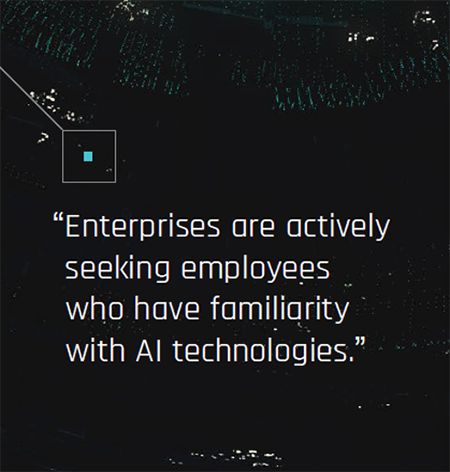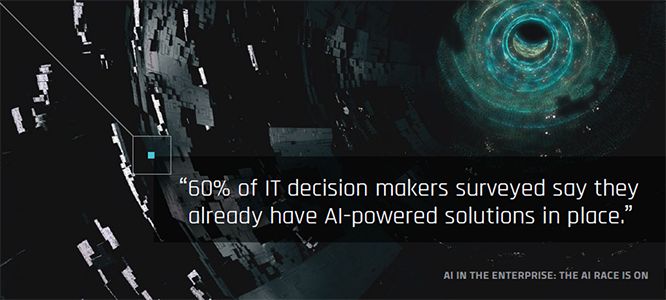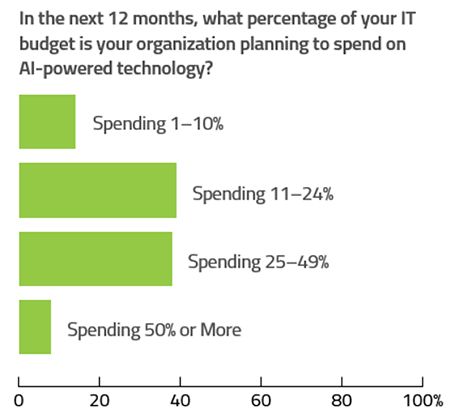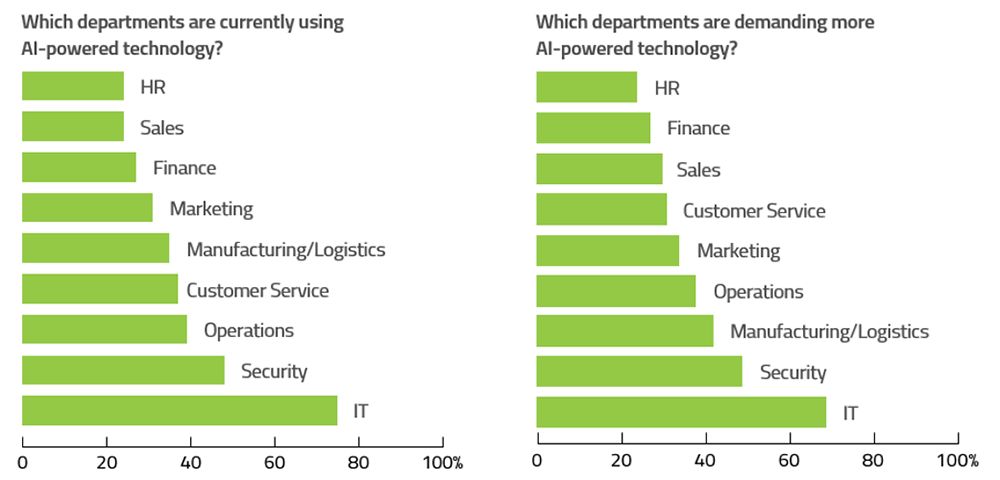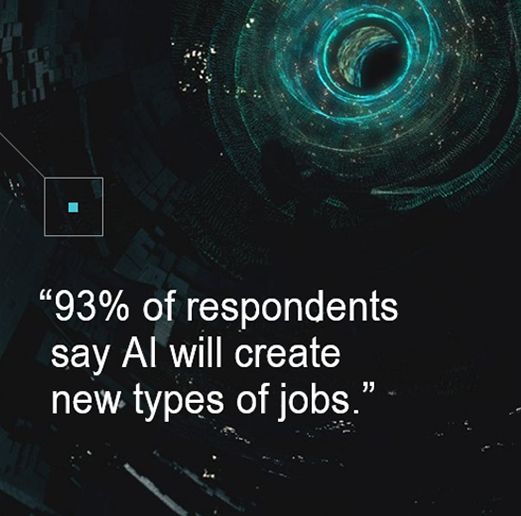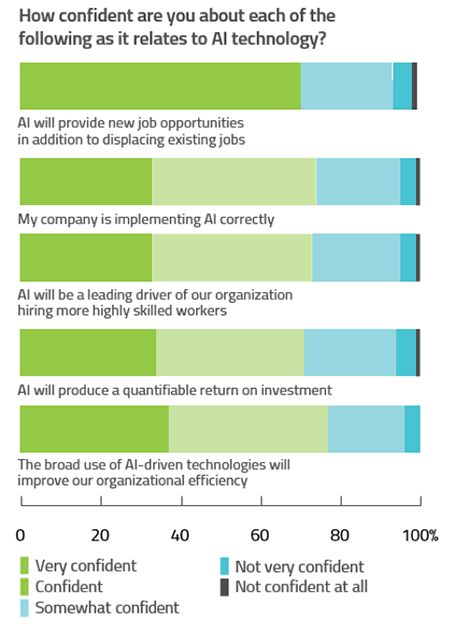Artificial Intelligence in the Enterprise: The Race Is On
Artificial Intelligence in the Enterprise: The Race Is On
Artificial intelligence (AI) is one of the hottest topics in today’s headlines. It powers natural language recognition for voice-powered assistants like Siri and Alexa, beats world-class Google Go players, and enables hyper-targeted e-commerce and content recommendations across the web on industry-giant websites that include Target and Netflix.
But recently, AI has begun actively expanding its footprint in the enterprise. Executives are trying to more fully comprehend what AI is and how they can use it to capitalize on business opportunities by gaining insight into the data they collect and engaging with customers more productively to hone their competitive edge. AI is the frontier of enterprise technology, but there remain many misperceptions about what it is and how it works.
Part of the confusion stems from the fact that AI is an umbrella term that covers a range of technologies—including machine learning, computer vision, natural language processing, deep learning, and others—that are in various stages of development and deployment. The use of AI for dynamic market-based pricing and targeted marketing has been spreading through corporations for a while, but actual AI computing where machines think like humans is still years in the future. The various possibilities prompt a range of reactions from people who understand AI’s disruptive potential.
DOWNLOAD THE FULL REPORT HERE.
As a field, artificial intelligence encompasses three distinct areas of research and practice:
- Artificial superintelligence is the type popularized in speculative fiction and in movies such as The Matrix. The goal of this type of research is to produce computers that are superior to humans in virtually every way, possessing what author and analyst William Bryk referred to as “perfect memory and unlimited analytical power.”
- Artificial general intelligence refers to a machine that is as intelligent as a human and equally capable of solving the broad range of problems that require learning and reasoning.
- Artificial narrow intelligence exploits a computer’s superior ability to process vast quantities of data and detect patterns and relationships that would otherwise be difficult or impossible for a human to detect, such as in the field of cybersecurity.
The research covered in this report focused on artificial narrow intelligence (referred to herein simply as AI) that is being targeted for specific business cases in the enterprise, like blocking malware and responding to intrusion attempts by bad actors.
Is enterprise AI just the next leader in the series of recent new technologies all touted as the holy grail of business innovation that will leave companies without them in the dust of tech transformation?
The Future of AI in the Enterprise
To answer this question, we partnered with Market Cube to commission a survey of more than 650 decision makers at large enterprises working across major industries in the U.S. and Europe and cross-functionally in the organization, from middle management to the corner office, to gauge their understanding of and investment in AI.
We asked a host of questions to find out where and how enterprises are using AI, what their future plans are, and what they think the impact of AI will really be on their organization.
The large enterprises that took part in our survey are bullish on AI. Nearly all say they are either currently spending on AI-powered solutions or planning to invest in them in the next few years. A majority also say they have AI solutions already in production. This percentage might seem high, but not if you consider that data-driven IT departments are often early adopters of new technologies and are always looking for ways to optimize processes and reduce costs.
- AI moves the needle on security: The survey found that 77% say they have prevented more breaches following their use of AI-powered tools, and 81% say AI was detecting threats before their human security teams could.
- Organizations plan to increase AI spend: Nearly all of the IT decision makers surveyed said they are either currently spending on AI-powered solutions, or planning to invest in them in the next two years. 60% already have AI in place.
- AI Is provides competitive advantage: 87% of IT decision makers see AI-powered technology as a competitive advantage for their IT departments, and 83% are investing specifically in AI to beat competitors.
- AI lives up to its promise: Despite the fact that 76% of respondents are concerned that marketing hype will make it difficult to vet AI-powered tech, 86% say the AI they’ve used has lived up to its promises. Furthermore, 64% of IT decision makers expect to see return on investment (ROI) from their investments in AI in fewer than two years.
- Concerns for job retention don’t outweigh opportunities: 68% of IT decision makers say AI will make certain jobs obsolete, and 74% are concerned AI technology will replace human jobs. But, 93% say it will create new job opportunities, and 80% believe AI will lead them to hire new workers and retrain existing employees.
Investment in AI
It appears we’ve finally reached a point where AI is shifting from talk to action, as companies have begun investing in AI in order to make better use of all the data they’re gathering and the increased computing power to which they have access. According to a recent McKinsey Global Institute Report, AI entrepreneurial investments were between $26 billion and $39 billion a couple of years ago, a three-fold increase over the previous three years. IDC predicts enterprise spending on AI and cognitive computing will grow to $46 billion by 2020.
Granted, most investment in AI comes from big players like Google, Amazon, and other big tech firms, but the AI spending fever is spreading. AI is being used to forecast electricity demand at utilities, to train vehicles to become chauffeurs and truck drivers, and to power robots that pack and ship Amazon orders. Netflix, for example, says the AI algorithm behind its search-and-recommendations engine has saved it US$1 billion in potential annual losses from canceled subscriptions.
According to the McKinsey report, early adopters tend to be technology, telecommunications, and financial services firms that deploy AI across technology groups and as a core part of their business. One thing they all have in common? All successful deployments have the full support of executive leadership.
Investment in AI
Specifically, the survey reveals:
- 60% already have AI in place.
- 39% of respondents say they will spend 11% – 24% of their IT budget – on AI over the next 12 months.
- 38% say they will spend a quarter to half of their IT budget on AI over the next 12 months.
The survey shows that IT decision makers see AI as a way to stay competitive and feel they will lose out if they don’t adopt it, particularly for IT and security departments. In addition, the competitive benefits AI provides can be seen across the organization.
- 83% say they are investing specifically in AI to beat competitors.
- 62% say they fear their competitors’ investments in the technology may pose a threat to their business.
- 87% of IT decision makers see AI as a competitive advantage for their departments.
- 79% believe AI will also benefit their security teams.
- 75% think AI will benefit manufacturing and logistics.
- 74% believe AI will benefit their customer service departments.
So, which industries and departments are investing in AI? According to the survey, the technology is primarily in use in the IT, security, operations, and customer service areas, while manufacturing and logistics are also among the top departments asking for it. As far as units within an organization, respondents say IT departments lead adoption at 75%, followed by security teams at 48% and operations at 39%.
As far as where respondents are feeling the most impact, IT, security, and manufacturing and logistics are the departments where AI has changed the way they work the most. In general, departments that traditionally deal with data and analytics are best positioned to take advantage of AI. Survey respondents say they were pleased with the results they’ve seen from their use of AI technologies.
While two thirds of respondents say they are concerned that marketing hype will make it difficult to vet AI-powered tech, nearly every respondent with an AI solution in place feels that the AI they’ve deployed has lived up to its promises. More than half expect to see ROI from their investments in AI within 24 months, particularly in the areas of improved operational efficiency, better business performance, and automation of repetitive tasks.
Perceptions of AI in the Enterprise
No study on AI would be complete without taking a look at how people think the technology might affect their jobs or their workforce. One of the biggest challenges to widespread adoption of AI is the perception that workers will be displaced. AI might require retraining staff for a number of jobs, but it will result in great productivity and efficiency gains, and the potential for greater job satisfaction as it will create vast new opportunities that will allow staff to use their brains for more critical thinking and less monotonous, mundane, repetitive tasks.
In other words, AI will change the nature of the work people do, moving it away from menial tasks to more strategic functions. It will be used to parse through data about customers, operations, business activities, and other processes that staff cannot compute or manage manually. But AI can’t operate on its own or in a vacuum; it needs humans to create the knowledge trees upon which the AI learns, and also to train and maintain the technology.
Job Creation
In the survey, concerns about job loss were heavily counterbalanced by expectations that the technology will result in new opportunities, including more meaningful work for employees and additional benefits throughout organization. Clearly the nature of some jobs within the enterprise will shift as a result of AI technologies, but most respondents predict new job creation as a result too.
Specifically, the survey reveals:
- 93% of respondents say AI will create new types of jobs
- 80% say AI will lead them to hire new workers and retrain existing employees
- 81% say AI will be a leading driver in allowing technical employees to do more meaningful work
- 74% say AI will enable less technical staff to use technology more effectively
Respondents with AI already in place report numerous benefits from their use of it. 84% of respondents say AI improved the overall quality of employees’ work, and 80% believe that teams using AI have become more productive. Meanwhile, 96% of respondents say they are confident that AI-driven technologies will improve organizational efficiency, and 94% are confident AI will produce a quantifiable return on investment.
Hiring rates are often an early indicator of the health of the job landscape for emerging technologies, and we’re already seeing increasing demand for data scientists and analytics experts who can help organizations make the most of AI technology. Our survey results show that IT leaders understand the workplace risks, but are willing to embrace the evolution of the workforce to more strategic and analytical functions.
Enterprises are actively seeking employees who have familiarity with AI technologies to help build out their AI capabilities—and job seekers are anticipating that need. 64% of respondents say that more candidates at every level are using AI as a differentiator on their resumes and in interviews. That is smart because 62% also reported that these skills are a deciding factor in the hiring process, and 61% say it is a critical hiring factor for security teams. 62% are even going so far as to ask candidates directly about AI during the interview process.
Security, Risk, and AI
Security is a strong application area where AI can be used to help teams make quick decisions and act on them. AI helps teams identify threats across an expanding attack surface (including mobile, cloud services, and the Internet of Things) by automating data aggregation across different data types, mapping it back to compliance requirements, and ruling out false positives.
The technology is also being used to help companies assess risk and potential harm to the business from specific threats using internal security data and external data on exploits, malware, and threat actors. In addition, AI can automate remediation processes that are used for incident reporting that can be augmented by staff analysis to boost effectiveness and reliability. AI is not just detecting threats; it also stops attacks from executing in the first place, entirely preventing future incidents such as data breaches.
Respondents in our survey reported that the AI is having a big impact on their security efforts. 70% say their security team is using AI in their threat prevention strategies, and 77% say they have been able to prevent more breaches since they began using AI-powered tools. 81% of respondents say AI was detecting threats before their security teams could, 78% say the technology has found threats humans couldn’t see, and 77% believe it is impossible for human-only cybersecurity teams to keep up with the threats.
In other words, AI tools—and we believe native AI technologies have the advantage here—are one of the most valuable weapons in the threat-prevention arsenal.
Importantly, AI doesn’t just make systems smarter, it makes employees smarter too, by enabling security and other workers to become more skilled. There are chatbot applications designed to help mentor junior security team members to use specific technologies and AI that adjusts the information it presents based on user skill level and knowledge. As IT departments try to attract employees across a broader range of skill levels, AI security products will evolve to become more flexible in terms of the assumptions about the user’s background and be more proactive about helping them learn.
Augmenting talent with robust AI solutions can help close the technology skills gap. This talent shortfall, especially in cybersecurity, is well documented and often remarked upon; some analysts predict that by 2022, the global shortage of cybersecurity professionals is expected to reach 1.8 million. Our survey respondents were optimistic that AI will help solve that problem.
Specifically, the survey shows that 81% of respondents believe that AI will help them solve the cybersecurity skills gap, and many have already seen their security teams to do more analytical, contextual, and highly skilled work as a result of their investments in AI.
The Future of AI in the Enterprise
In addition, there seems to be no question that AI is the next wave of digital transformation for most IT decision makers. 84% say AI-powered technology was part of their digital transformation strategy, and 81% say it’s critical for the success of those initiatives. While companies may feel pressure to adopt AI, they should realize that without a strong digital foundation in place, the AI may be limited.
As a result, the technology can serve as a forcing function.Unlike other areas of IT spending, the AI discussion is akin to the cloud debate because it involves executives at the highest levels of the organization including teams that lead the strategy and transformation efforts organizations require to gain competitive advantage. Boards and C-suite executives are key stakeholders in these conversations; their support is required for AI initiatives to commence and be successful.
While the value of AI is apparent to IT leaders, it’s not always easy to figure out which vendors to choose. 65% of respondents say that market noise around AI makes it difficult to understand the difference between all the different solutions when much of their marketing materials look and sound the same. Clearly, IT decision makers know AI will be important, and they know it can provide a strategic advantage, but they don’t really know how or where to start. What’s more, there are network effects with AI, so scaling is exponential.
In other words, the leaders of the pack, the first adopters, are making sizable headway and their advantage is immediately and increasingly defensible.
Evaluating AI Solutions
Unfortunately, there is no standard, one-size-fits all “how-to” guide for choosing the best AI solution; they vary substantially by application and industry. As with other technology investments, there are a few simple rules of thumb that executives can use:
- Request customer references to find out how their adoption is going and what the pain points and challenges are, if any.
- Ask for a demo and use your own data — ideally, choose a demo that stands alone and not in the cloud so you can see that the software itself, not an analyst behind a curtain, is processing your data.
- Inquire about what vendor data sources are, as well as the size of the data set, parameters, and capacity.
- Ask about the algorithm being used, including what data is encoded and decoded, how the neural network is implemented, and other technical aspects to their approach.
- Compile requirements for compatibility, functionality, user experience, and price ahead of time.
Based on our survey responses, it’s clear that enterprises are using AI to varying degrees and that executives understand the benefits it can provide for near- and long-term operational and market advantage. Enterprises would be wise to ramp their efforts to evaluate AI solutions now.
Just as companies that embraced early Internet and cloud opportunities saw positive impact to their business results, operational effectiveness, and market position, organizations that see AI as a strategic differentiator and support AI adoption will find themselves ahead of the curve instead of behind it.
DOWNLOAD THE FULL REPORT HERE.
Editor’s Note: This report was originally published in Issue 1 of BlackBerry Cylance’s bi-annual print publication, PHI Magazine. The digital version of this magazine can be viewed and downloaded here.
*** This is a Security Bloggers Network syndicated blog from Cylance Blog authored by The BlackBerry Cylance Team. Read the original post at: https://threatvector.cylance.com/en_us/home/artificial-intelligence-in-the-enterprise-the-race-is-on.html





